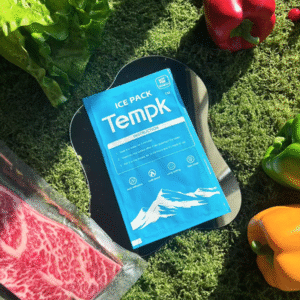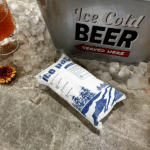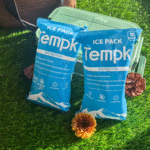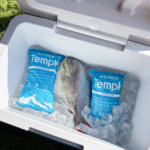How to Choose Dry Ice Sheet Dry Ice Packs in 2025
Updated October 2025. If you need frozen reliability without melting mess, dry ice sheet dry ice packs deliver steady sub‑zero performance for food, farmacéutico, y laboratorios. You’ll keep products at −20 °C or colder, because CO₂ sublimates at −78.5 °C and absorbs significant heat as it vaporizes. En esta guía, you’ll size the load, build a pack‑out, and meet safety rules—so you ship confidently and cut claims.
-
Sizing basics: Quick math to right‑size dry ice sheet dry ice packs for your lane
-
Pack‑out templates: Layering patterns that reduce hot spots in transit
-
Compliance roadmap: Etiqueta, ventilación, and handling for UN1845 dry ice
-
Costo y sostenibilidad: Use less CO₂ by combining insulation and layout
-
Alternatives and hybrids: When PCM or gel packs beat dry ice for your job
What exactly are dry ice sheet dry ice packs—and when should you use them?
Respuesta corta: Dry ice sheet dry ice packs are preformed, vented CO₂ modules that hold “dry ice snow” in a gas‑permeable wrap. They act like flat bricks or flexible mats. Use them for frozen lanes (−20 °C to −30 °C targets), fast pre‑packing, and tidy returns where pellets would scatter.
Details you can use: Think of pellets as sand, blocks as bricks, y dry ice sheet dry ice packs as “tiles.” Tiles spread cold evenly, fill corners, and won’t leak water. They vent CO₂ safely while containing fragments. Choose them for frozen meals, biológicos, helado, and field kits. If you need 2–5 days under −10 °C, they shine. For deep‑frozen beyond −40 °C or very long lanes, combine with better insulation or supplemental blocks.
How do dry ice sheets compare to pellets, bloques, and gel packs?
Deeper dive: Sheets give you predictable coverage and quick packing. Pellets pour fast but shift during transit. Blocks last longest by mass but leave cold gaps. Gel packs hold 0–8 °C or ambient; they can’t reach dry‑ice temperatures. For mixed SKUs, capa dry ice sheet dry ice packs around the product footprint to control face temperature and reduce cold burns.
| Cooling Format | Manejo | Tener tiempo (like‑for‑like mass) | Lo que significa para ti |
|---|---|---|---|
| Sheets/Packs | Pre‑sized, tidy, ventilado | Long and even | Uniform cold face; fast SOP training |
| Bandear | Fast to dose; free‑flowing | Moderado | Good for high‑volume hubs; needs liners |
| Blocks/Slabs | Heaviest; fewer pieces | Longest | Lo mejor para carriles largos; watch cold spots |
| Gel/PCM 0–8 °C | Limpio, reutilizable | Not for frozen | Use only for chilled, no congelado |
Consejos y consejos prácticos
-
Frozen meals box: Usar dry ice sheet dry ice packs above and below trays to minimize top‑surface thaw.
-
Clinical kits: Use a U‑wrap of sheets to protect vials, with a vent path at lid.
-
Carriles largos: Add one block plus sheets as side “curtains” for stability.
Caso del mundo real: A meal‑kit brand replaced pellets with dry ice sheet dry ice packs in a VIP shipper. Claims dropped by a third over 8 semanas, while pack time fell from 3.5 a 2.2 minutes per box.
How much dry ice sheet dry ice packs do you need?
Respuesta corta: Start with heat load. Estimate how much heat sneaks into your shipper per hour, multiply by transit hours, then divide by the energy dry ice removes when it turns to gas. Then add 10–30% buffer for handling and delays.
Details you can use: Dry ice absorbs a lot of heat as it sublimates. To stay simple, treat your shipper like a leaky thermos. More surface area, lower R‑value, and higher ambient mean more leakage. Dry ice sheet dry ice packs work best when you build an envelope around the product and leave a top vent path. Calcular, then validate with a lane test.
A back‑of‑envelope calculator you can copy
Utilice este estimador rápido. It trades lab equations for practical planning while staying conservative.
Ejemplo: A medium EPS shipper (A≈0.6 m², R≈0.35) at 30 °C for 48 h → Q≈(0.6/0.35)×50≈85.7 W.
m≈(85.7×48×3.6)/571≈25.9 kg. Agregar 20% → ~31 kg. Use a mix of blocks and dry ice sheet dry ice packs to distribute cold.
| Variable | Rango típico | How to pick | Para ti |
|---|---|---|---|
| R‑value (EPS 25 mm) | 0.3–0.4 | Use lab spec, not guess | Prevents under‑packing |
| R‑value (Revestimiento) | 2.0–3.0 | Higher is better | Cuts CO₂ by 40–70% |
| Buffer | 10–30% | New lanes need more | Insurance for delays |
Consejos y consejos prácticos
-
Short lanes (<24 H): Favor dry ice sheet dry ice packs for even coverage, not just blocks.
-
Hot climates: Increase side “curtains” of sheets to shield walls.
-
Returns: Keep spare sheets for reverse logistics and field swaps.
Caso del mundo real: A CRO added 15% más dry ice sheet dry ice packs at the lid for a tropical route. Max payload temperature dropped by two notches during ramp delays.
Are dry ice sheet dry ice packs safe and compliant?
Respuesta corta: Yes—when you vent and label correctly. Dry ice sheet dry ice packs must release CO₂ gas as they warm. Use a vented shipper lid, apply UN1845 labeling, and train handlers for CO₂ hazards.
Details you can use: El gas CO₂ desplaza al oxígeno. Never trap dry ice in a sealed tight container. Keep packs out of confined spaces and vehicles without ventilation. Mark the net dry ice mass on the box, and place the proper hazard label. Para el aire, follow airline limits and documentation rules. Para suelo, follow dangerous goods guidance and site SOPs. Reference frameworks include IATA Packing Instructions for dry ice, DOT/ADR markings, and workplace safety training.
Compliance checklist for frozen shipments
Use this pre‑ship list before every tender. It keeps audits painless and employees safe.
| Tema | Que hacer | Where it lives | Para ti |
|---|---|---|---|
| Desfogue | Confirm lid vents or pressure path | Shipper SOP | Prevents bulging |
| UN1845 | Label and write net mass of dry ice | Box exterior | Passes acceptance |
| Documento | Add CO₂ entry to airway bill if required | Air freight file | Avoids holds |
| PPE | Gloves/eye protection for packers | Site PPE policy | Prevents cold burns |
| Capacitación | DG awareness + CO₂ hazard | HR/LMS record | E‑E‑A‑T and audit trail |
Consejos y consejos prácticos
-
Small parcel air: Double‑check airline limits for dry ice mass per shipper.
-
Depósito: Almacenar dry ice sheet dry ice packs in ventilated rooms.
-
Vehicles: Crack windows or use fans when carrying multiple shippers.
Caso del mundo real: A 3PL moved to vented lids and refreshed DG training. CO₂ alarm events dropped to zero across two quarters.
Will dry ice sheet dry ice packs lower your total cost?
Respuesta corta: Often yes. You save on labor and reduce spoilage. Dry ice sheet dry ice packs pack faster than pellets and reduce rework. Better insulation lowers CO₂ mass further.
Details you can use: Cost is not only CO₂ price per kilogram. Mano de obra, reclamos, repacks, and airline rejection fees add up. Sheets standardize the pack‑out, so you hire faster and make fewer mistakes. In many lanes, a VIP liner plus dry ice sheet dry ice packs cuts CO₂ usage dramatically while extending hold time. Pista cost per successful delivery, not just material cost.
A simple cost model you can adapt
| Lever | Typical effect | How to pull it | Para ti |
|---|---|---|---|
| Insulation upgrade | Less dry ice | Add VIP liner | Menor, lighter box |
| Pack time | Faster by 20–40% | Use pre‑sized sheets | Lower labor cost |
| Claims | Down 20–40% | Even cold face | Better NPS, fewer refunds |
Consejos y consejos prácticos
-
Piloto: A/B test pellets vs dry ice sheet dry ice packs for two weeks.
-
Pista: Measure pack minutes, claim rate, and returns.
-
Escala: Standardize the winning SOP and retrain.
Caso del mundo real: A dessert brand swapped to sheets in 70% of SKUs. Boxes shrank one size, and freight plus CO₂ spend fell by mid‑teens percent.
How do dry ice sheet dry ice packs compare with gel packs and PCM?
Respuesta corta: Si lo necesitas congelado, dry ice sheet dry ice packs ganar. If you need 0–8 °C, use gel or PCM. Para cargas mixtas, build hybrids.
Details you can use: Gel packs target chilled zones and stop freeze damage in produce or biologics. Materiales de cambio de fase (PCM) can hold precise setpoints like −21 °C or +5 °C. A hybrid uses a thin PCM layer on product to prevent “cold burn,” plus dry ice sheet dry ice packs around the walls and lid for capacity.
Hybrid pack‑outs that work
| Meta | Layer near product | Outer layer | Para ti |
|---|---|---|---|
| −20 °C sensitive vials | PCM −21 °C slab | Dry ice sheet dry ice packs | Prevents over‑freezing |
| Mixed frozen/chilled | PCM +5 °C wrap | Dry ice sheets top only | Dual‑zone in one box |
| Ice cream TLC | Spacer board | Sheets as a lid | Stops lid frostbite ring |
Consejos y consejos prácticos
-
Chilled only: Skip dry ice and use PCM/gel to avoid freeze claims.
-
Congelado: Usar dry ice sheet dry ice packs for even spread; add one block for long lanes.
-
Mixed: Separate zones with cardboard baffles.
Caso del mundo real: A vaccine trial used PCM −21 °C on vials and dry ice sheet dry ice packs afuera. Temperature stayed in range while avoiding cold shock.
Packaging design: revestimiento, respiraderos, datos, and pack‑out templates
Respuesta corta: Pair insulation with proper airflow. Dry ice sheet dry ice packs need a vent path and even contact. Templates make results repeatable.
Details you can use: Pick insulation by R‑value and route temperature. Add a foil or bubble liner to cut radiant heat. Keep a 5–10 mm gap above sheets for CO₂ flow. Use a data logger in the warmest point (often center top) to validate.
Ready‑to‑use pack‑out templates
| Componente | Bien | Mejor | Mejor | Para ti |
|---|---|---|---|---|
| Aislamiento | EPS 25 mm | PUR 40 mm | Revestimiento | Less CO₂, smaller box |
| Transatlántico | PE bubble | Foil bubble | Frustrar + edge tape | Stops radiant gain |
| Cierre | Regular lid | Tapa ventilada | Ventilado + espaciador | Steady CO₂ flow |
Consejos y consejos prácticos
-
Edge tape: Seal liner seams to stop warm air leaks.
-
Hot lanes: Double the sheets on sun‑facing side.
-
Audits: Keep lane test graphs with SOP printouts.
Caso del mundo real: After adding vented lids and side curtains of dry ice sheet dry ice packs, a seafood exporter reduced lid bulges and improved arrival texture.
2025 trends shaping dry ice sheet dry ice packs
Descripción general de la tendencia: En 2025, shippers push for lighter boxes, lower emissions, and simpler SOPs. Dry ice sheet dry ice packs fit that shift. Expect more high‑R liners in standard sizes, better gas‑permeable wraps that dust less, and wider hybrid use with −21 °C PCMs. Carriers continue tightening acceptance steps, so clean labeling and mass accuracy matter more than ever.
¿Qué hay de nuevo a un vistazo?
-
Dust‑reduced wraps: Cleaner pack lines and faster QC.
-
Standardized templates: Pre‑approved layouts for big retailers and trials.
-
Smart validation: More wireless sensors to verify hold time without opening.
Insight del mercado: Brands replace pellets in repetitive SKU pack‑outs because labor is scarce and quality targets are strict. Dry ice sheet dry ice packs plus VIP liners often cut CO₂ mass and claims while improving unboxing. Expect more “hybrid frozen” designs to reduce over‑freezing risk in sensitive items.
Preguntas frecuentes
Q1: How long do dry ice sheet dry ice packs last in transit?
Plan by heat load and insulation, not the clock. With VIP liners, dry ice sheet dry ice packs can hold 48–72 h for many frozen meals. Always lane‑test your route and add buffer.
Q2: Can I ship by air with dry ice sheet dry ice packs?
Sí, if you follow airline limits and label UN1845 with net mass. Use a vented lid and document the mass on the box to pass acceptance.
Q3: Will dry ice damage my product?
Direct contact can over‑freeze or crack packaging. Wrap product or use a thin PCM layer, then surround with dry ice sheet dry ice packs for capacity.
Q4: Are sheets food‑safe?
Use food‑contact rated wraps when shipping food. Mantener dry ice sheet dry ice packs outside primary packaging unless specified safe for direct contact.
Q5: What about sustainability?
CO₂ in dry ice is often reclaimed from industry. Use VIP liners to reduce mass, and right‑size boxes to cut freight and CO₂ usage.
Q6: How do I store the packs?
Mantener dry ice sheet dry ice packs in ventilated, insulated bins. Avoid sealed rooms and keep people trained on CO₂ safety.
Q7: Can I reuse the sheets?
No. Dry ice sublimates to gas. Reuse the shipper and liner; replenish with new dry ice sheet dry ice packs.
Resumen y recomendaciones
Control de llave: Usar dry ice sheet dry ice packs when you need frozen reliability, clean handling, and fast training. Size by heat load, not guesses. Vent and label to pass audits. Upgrade insulation or add PCM for sensitive goods. Standardize pack‑outs, then test and tune.
Siguientes pasos: Pick your shipper class (EPS/PUR/VIP), run the simple mass estimate, and trial two pack‑out templates for your hottest route. Record results, lock the SOP, and train the team. Habla con Tempk for a tailored pack‑out and validation plan.
Acerca de Tempk
Tempk builds practical cold chain solutions that combine pack‑out templates, high‑R liners, and data validation. We help brands deploy dry ice sheet dry ice packs and hybrid designs that cut claims and speed training. Our customers see faster pack lines and steadier delivery quality with fewer temperature excursions.
Llamado a la acción: Contact Tempk for a route‑specific design and a 2‑week lane trial.
























